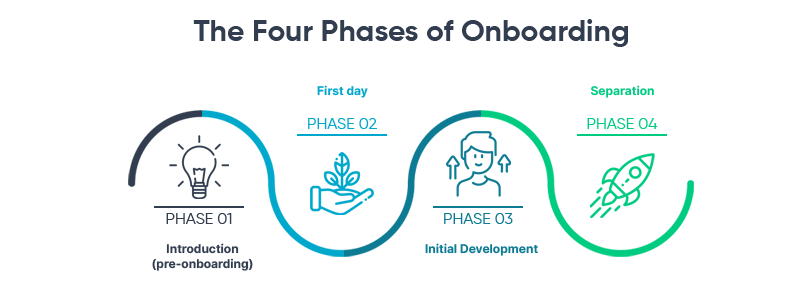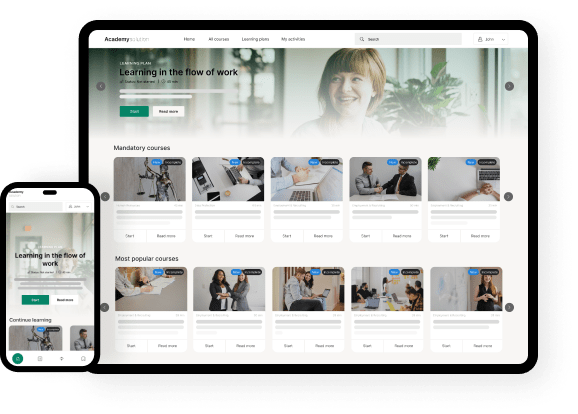Shifting to an online onboarding process is practical, especially now when we’re in the middle of a global pandemic. But before you make the shift, there are a few things you should keep in mind. First off, you need to acknowledge that it for some new employees might be difficult to partake in an online onboarding process. And therefore, our first advice for you is to steer clear of all “one-size-fits-all” approaches since they can throw a wrench into the works.
All new employees will have different needs, so generic and outdated online onboarding modules are far from useful. With a standard onboarding package, you might also unintentionally set unrealistic expectations that some of your new recruits might struggle with. These online onboarding woes can develop over time and even lead to bigger problems such as poor employee retention.
So, before you make the shift, read along and get our expert tips to help you succeed in your online onboarding process and establish continuity in your employee training program.
1. Break your online onboarding process into four phases
Giving trainees a one-size-fits-all onboarding program is a big no-go. Administrators tend to forget that the needs of employees evolve as the onboarding training progresses. And failing to identify or address what matters most to your employees can cause their engagement and productivity to drop significantly or even fully disappear.
Therefore, we suggest splitting your onboarding program into different stages. Visualizing and mapping out employees’ journeys — from their first day, right through the moment they receive a promotion — will give you a deeper understanding of their development. Not only that, but it also helps you appreciate their undertakings even more.
Generally, the onboarding process has four phases: introduction (pre-onboarding), first day, initial development, and separation. The same thing applies to any digital or online onboarding program.

Source: Peakon
Phase 1: Pre-onboarding
Many don’t realize how crucial a part of pre-onboarding can be of an employee’s hiring experience. Some don’t even see the difference between pre-onboarding and the actual onboarding process.
Pre-onboarding should begin the moment an applicant signs an offer letter and thereby accepts the job. The onboarding process, on the other hand, starts when the new employee walks through the office doors and are ready to begin the different onboarding processes such as orientation, profile completion, and system training.
During the pre-onboarding stage and up until the onboarding starts, the employer should keep in touch and interact with new employees. Though, the reality is that not all companies have the time to communicate with their employees before their onboarding program begins. However, it’s a crucial component in order to excite and motivate newly hired employees.
While pre-onboarding is as essential as the onboarding process itself, you don’t want to overdo it. In an online pre-onboarding, what matters most is how you set the tone and deliver the message.
Online pre-onboarding can be as simple as:
- Sending a welcome email or video greeting
- Keeping new employees in the loop through video conferences
- Building connections through social media
- Sharing relevant information via email or a learning portal
The time between offer acceptance and an employee’s first day can be thrilling, exciting, and even filled with apprehension. So, ensuring that this period becomes a fantastic experience can make all the difference for your new employee.
Phase 2: First day of onboarding
We all know how uncomfortable and uncertain things can be when you’re new to something or somewhere. In a typical physical onboarding setup, the first day should include an informal gathering to give employees time to calm their nerves. You could for example gather the whole team for a joint breakfast or lunch.
While digital onboarding can provide new employees with a convenient space, it may be difficult for them to stay connected and at ease.
That’s why during the first day of their virtual onboarding program, you need to turn their anxiety into excitement. This can be done by employing virtual icebreakers such as online charity events or quizzes to help them connect with their team members.
These simple online activities are especially important if your employees are still working from home.
Phase 3: Initial development
The third phase of your employees’ onboarding program is the “cultivation” stage, which is all about initial development.
The first two weeks of any onboarding training should be focused on helping your employees find the right footing within the company. Hereafter you’re ready to dig into talent management and begin nurturing and harvesting your new recruit’s potential and skills. This stage, therefore, requires constant coaching and crafty mentoring.
At this point, a successful onboarding participant must manifest the following:
- Self-efficacy
- Role clarity
- Social integration
- Awareness of organizational culture
To succeed in embedding these fundamentals, you must emphasize collaborative onboarding. Collaborative onboarding calls for cross-departmental engagement, which can help break down silos and foster team connections. And the best way to tap this strategy is by using a Learning Management System.
Phase 4: Separation
Seeing that the objective of onboarding is to improve employee retention, it might seem weird to include separation as part of the process. Yet, there’s a very good reason for including this phase in your process.
For all sorts of reasons, there will always be someone who will decide to leave your organization. Maybe the reason is personal and not directly related to their work experience. But sometimes, there will be issues in your company that may lead to your employees’ departure.
Nonetheless, the separation phase must be considered a golden opportunity to study employees’ behavior and learn why they leave. In the end, this phase can help you minimize employee turnover by addressing its causes.
Employee turnover can be costly and should therefore be a significant concern for companies. In fact, studies say that the average replacement cost of a regular employee is six to nine months of his or her salary.
Gathering insights on the causes of staff attrition is a difficult task, but by conducting regular engagement surveys you’ll always have data on hand whenever an employee decides to resign. Online engagement surveys can shed light on matters that your employees are unwilling to share among their peers and supervisors and might provide an explanation.
2. Implement a buddy system
One of the downsides of virtual onboarding is that it increases the level of isolation among new employees. If there is not enough online interaction to foster active engagement, the new recruit can quickly feel abandoned.
A buddy system ensures that new workers have someone to talk to and share their sentiments regarding their onboarding experience with. A buddy system can also be an unstructured form of knowledge sharing. You can easily relay essential industry-related information, tips, and techniques through this system, which workplace buddies have learned from their current job role or previous work experience.
According to the Society for Human Resource Management (SHRM), a buddy system helps build an “immediate personal connection between the new employee and the organization”.
The buddy can make the new employee feel welcome, answer questions and help the new person navigate through the organization’s culture. This leads the new employee to feel comfortable sooner and to achieve a sense of acceptance and belonging.
In an online onboarding process, a buddy system can help:
- Make the new employees feel welcome by assisting them in navigating through the company’s online platform and the organization’s culture
- Fix the gap between new and old employees by making the senior ones more available for questions that new hires can’t discuss with the supervisors or managers
- Keep the lines of communication open while respecting boundaries and confidentiality
A buddy shouldn’t be mistaken for a supervisor or a mentor. A buddy isn’t someone who’s supposed to help the new hire develop skills and job performance. And a buddy isn’t required (unless requested) to create a peer review or provide unsolicited advice.
According to Project Manage Institute, a buddy is someone who can “epitomize your company’s values and be familiar enough with the formal and informal organizational structures to be a reliable source of information”.
For Nicole Miller, People Operations Manager at Buffer, there are three types of buddies you can use for a better onboarding process:
Role buddy
Role buddies are those who can walk new employees through their job expectations — people who can provide immediate feedback and encouragement.
Culture buddy
A culture buddy is a peer who can provide newly hired employees an overview of the company’s history and culture. According to Miller, this type of buddy can initiate fun group-chat channels to offer support to those who struggle in the workplace.
Mastermind buddy
A mastermind buddy plays a vital role in the transitioning process of the new employee. He or she is a peer who shares a “similar journey and common interests”. A mastermind buddy is someone who can help new employees establish deeper connections through his or her personal stories.
As more companies turn to remote onboarding, welcoming employees and establishing an effective transition can be tricky. However, creating a buddy system to help new hires cope with their loneliness can boost their success.
3. Pick the best onboarding platform
As you continue to optimize your corporate training program, you must always be aware of the top trends in employee onboarding. Whether you like it or not, modern technology will remain at the center of every corporate process – especially in the coming years.

Source: Source Group International
Companies must choose the right solution or technology to stay on top of the HR management echelon. With regards to picking the best onboarding platform, you must consider these three things:
Personalization
Is your onboarding platform effective enough to cater to differentiating needs? Does it have features that allow greater flexibility, access to different media, and options to map out new employee’s skills data against the requirements of their role?
Your onboarding platform should be able to accelerate new hire productivity, improve satisfaction, and enhance engagement. Your platform should help new employees accomplish practical tasks without any hassle.
Automation
Automated workflows and online portals give you a standardized and more consistent approach to your virtual onboarding process. While traditional onboarding programs possess the right pieces to create an effective onboarding program, automating the process can make it even more efficient.
Imagine automating your onboarding workflow that can cover the entire employee lifecycle—from pre-hire to offboarding.
During the pre-onboarding phase, you can streamline your recruitment and application process and interview feedback and tracking. Additionally, using a platform during the actual onboarding can help you automate collecting new hire information. And when the offboarding period arrives, the right solution can help you administer digital surveys, goals tracking, and certification management.
Accessibility and inclusivity
If you want to be successful in your online onboarding, your mantra should be accessibility and inclusivity. Accessibility and inclusivity go hand in hand because both are factors to a positive onboarding experience.
Accessibility in onboarding platforms means the availability of essential training resources, whether external or internal. Availability then leads to process immediacy that causes a smooth and uninterrupted flow of work.
For onboarding solutions, accessibility can mean responsiveness in design, user-friendliness, and customizability.
Inclusivity, on the other hand, can be synonymous with universality. It means that the onboarding solution must be designed so that it’s usable by all people, especially those with special needs. A platform that has an inclusive or universal design can:
- Provide identical user experience for all
- Accommodate individual preferences and abilities
- Communicate information effectively regardless of user’s conditions
- Simplify the process no matter whatever user’s language skills and experience possess
To avoid roadblocks in your online onboarding training, look into your platform’s capacity to provide accessibility and promote inclusivity.
Level up your online onboarding with Cursum
At Cursum we don’t believe there is one best way to learn. However, we know that the secret to creating a consistent training program is an easy-to-use and easily integrable platform.
Understanding innovation, we offer a smart solution that can turn your ideas into something that adds essence to your company’s value chain. Contact us today to learn how we can help you build a solution that will level up your online onboarding process!


